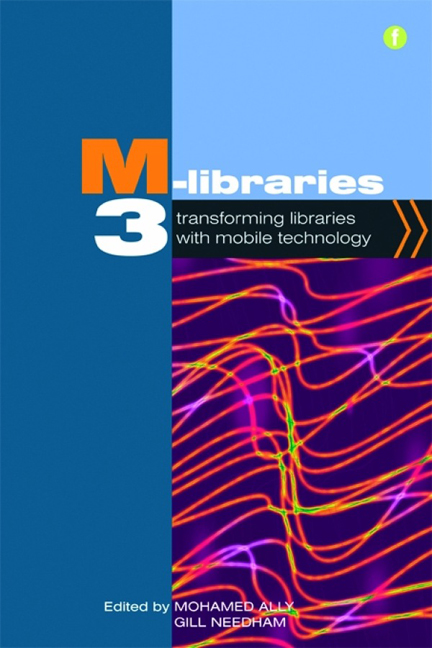Book contents
- Frontmatter
- Contents
- Acknowledgements
- Contributors
- Foreword
- Introduction
- 1 Education for all with mobile technology: the role of libraries
- PART 1 DEVELOPING MOBILE SERVICES
- 2 Preparing for the mobile world: experimenting with changing technologies and applications for library services
- 3 Enhancing open distance learning library services with mobile technologies
- 4 Use of mobile phones in the delivery of consumer health information
- 5 Deploying an e-reader loan service at an online university
- 6 Mobile service providers and library services in a multi-campus library
- 7 Using mobile technology to deliver information in audio format: learning by listening
- 8 Sound selection: podcasts prove positive
- PART 2 PEOPLE AND SKILLS
- PART 3 FOCUS ON TECHNOLOGY
- Conclusion
- Index
4 - Use of mobile phones in the delivery of consumer health information
from PART 1 - DEVELOPING MOBILE SERVICES
Published online by Cambridge University Press: 08 June 2018
- Frontmatter
- Contents
- Acknowledgements
- Contributors
- Foreword
- Introduction
- 1 Education for all with mobile technology: the role of libraries
- PART 1 DEVELOPING MOBILE SERVICES
- 2 Preparing for the mobile world: experimenting with changing technologies and applications for library services
- 3 Enhancing open distance learning library services with mobile technologies
- 4 Use of mobile phones in the delivery of consumer health information
- 5 Deploying an e-reader loan service at an online university
- 6 Mobile service providers and library services in a multi-campus library
- 7 Using mobile technology to deliver information in audio format: learning by listening
- 8 Sound selection: podcasts prove positive
- PART 2 PEOPLE AND SKILLS
- PART 3 FOCUS ON TECHNOLOGY
- Conclusion
- Index
Summary
Introduction
The mobile phone is increasingly becoming a significant healthcare enabler and delivery tool. It is evident that its popularity is due to its worldwide connectivity, coverage, ease of use, immediacy, costeffectiveness and diverse capabilities. There are at least six times more mobile phone owners than computer owners in the world (Peres, 2009). Many predict that by 2013, 95% of the entire world population will have a mobile phone. The technology has become affordable and the infrastructure is widespread (Hyett, 2010). It is easier, cheaper and faster for physicians, residents and medical science students working in emergency rooms to exchange health information, consult their peers and seniors and keep up to date through mobile phones than via computer, internet and personal contact. Downloading, sharing copies of reference books, images, rare cases for discussion – all can be carried out effectively via mobile phone. Bluetooth is prevalent among medical science students and residents. Blackberries, PDAs and iPhones can be used as tools for connecting people socially and connecting them to the internet. In the patient–doctor relationship mobile phones can be used for the delivery healthcare and health information by either health information specialists or health providers. There are many studies reporting the use of mobile phones in the patient–doctor relationship (Prociow and Crowe, 2010; Varnfield et al., 2011), monitoring of patients with chronic diseases (Tirado, 2011), HIV education (Chiasson, Hirshfield and Rietmeijer, 2010), behavioural research (Prociow and Crowe, 2010) and treatment and healthcare (Lim et al., 2011; Maddison et al., 2011; Riva et al., 2011).
Mobile phone take-up isn't a phenomenon of the developed world only. Developing countries, such as China, India and many countries in Africa, are adopting the mobile phone at an amazing rate (Bon Tempo, 2011).
On the one hand, patients seeking health information have better access to mobile phones than to computers; and on the other hand, it is evident that demand for evidence-based consumer health information (CHI) has increased. In consequence, it is essential to implement the capabilities of emerging technologies so as to connect evidence-based CHI, health providers and health consumers. In Iran, a developing country, the majority of patients require health information and information prescriptions for the treatment, diagnosis and management of diseases (Gavgani, 2010a). There are projects using mobile phones, especially SMS, for health information delivery to patients in Iran, although not library-based information services.
- Type
- Chapter
- Information
- M-Libraries 3Transforming libraries with mobile technology, pp. 33 - 42Publisher: FacetPrint publication year: 2012



